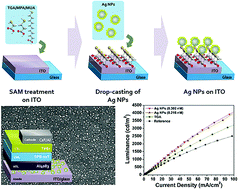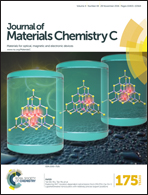Enhanced performance of blue polymer light-emitting diodes by incorporation of Ag nanoparticles through the ligand-exchange process†
Abstract
A coupling interaction between localised surface plasmon resonance of metal nanoparticles (NPs) and emitting materials has been shown to improve the internal quantum efficiency in organic light-emitting diodes. In this research, Ag NPs were introduced into blue polymer light-emitting diodes (PLEDs), which suffer from low efficiency. Ag NPs were attached to the indium tin oxide (ITO) surface through a ligand-exchange process, which guarantees well-dispersed Ag NPs, to maximise resonant coupling and to prevent optical and electrical side effects. Mercaptoacid molecules not only function as a coupling agent between ITO and Ag NPs, but also aid the transfer of holes by increasing the work function of ITO, as confirmed by tests on hole-only devices and by ultraviolet photoelectron spectroscopy. Maximum current efficiencies of blue PLEDs improved by 25% with thioglycolic acid (TGA) only and by 48% with 0.302 nM Ag NPs attached to TGA. We confirmed from time-resolved photoluminescence spectra and normalised electroluminescence spectra that the enhancement mechanism is the resonant interaction between Ag NPs and the blue light-emitting polymer, SPB-02T.


 Please wait while we load your content...
Please wait while we load your content...